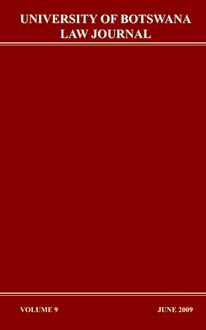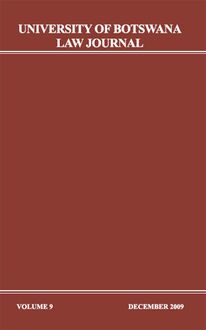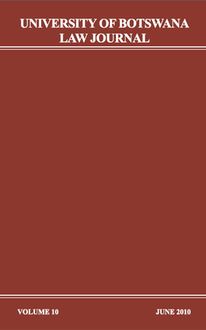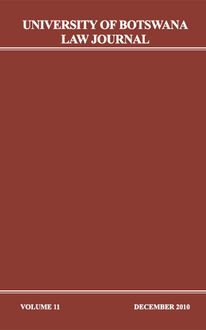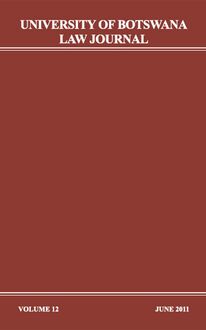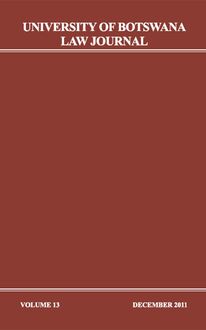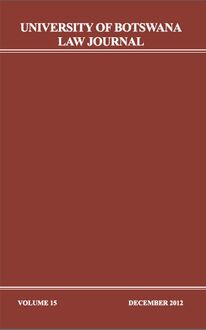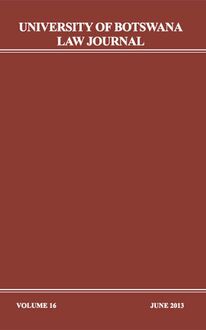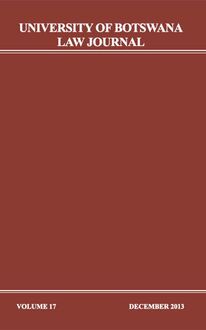-
 Univers
Univers
-
 Ebooks
Ebooks
-
 Livres audio
Livres audio
-
 Presse
Presse
-
 Podcasts
Podcasts
-
 BD
BD
-
 Documents
Documents
-
- Cours
- Révisions
- Ressources pédagogiques
- Sciences de l’éducation
- Manuels scolaires
- Langues
- Travaux de classe
- Annales de BEP
- Etudes supérieures
- Maternelle et primaire
- Fiches de lecture
- Orientation scolaire
- Méthodologie
- Corrigés de devoir
- Annales d’examens et concours
- Annales du bac
- Annales du brevet
- Rapports de stage
La lecture à portée de main
96 pages
English
University of Botswana Law Journal Volume 9, December 2009 , livre ebook
96 pages
English
YouScribe est heureux de vous offrir cette publication

Description
The University of Botswana Law Journal is a peer refereed journal published twice a year. It provides a forum for scholars and practitioners to reflect on diverse legal issues of national, regional and international significance and of local and regional relevance.Editorial Board:Prof. P. N. Takirambudde Editor-in-Chief, University of BotswanaMrs. E. Macharia-Mokobi Secretary, University of BotswanaDr. K. Solo Judge of High Court of Botswana Prof. C. Ngongola University of BotswanaProf. J. Kiggundu University of BotswanaProf. E. K. Quansah University of BotswanaDr. O. B. Tshosa Judge of High Court of BotswanaMr. T. Sebogo Vice chairman, Law Society of Botswana
Sujets
Informations
| Publié par | PULP (Pretoria University Law Press) |
| Nombre de lectures | 0 |
| Langue | English |
Extrait
UNIVERSITY OF BOTSWANA LAW JOURNAL The University of Botswana Law Journal is a peer refereed journal published twice a year. It provides a forum for scholars and practitioners to reflect on diverse legal issues of national, regional and international significance and of local and regional relevance. PATRON The Hon. Justice Nganunu, Chief Justice of Botswana. INTERNATIONAL EDITORIAL ADVISORY BOARD Prof. D. D. N. Nsereko, Judge,InternationalProf. S. Roberts Criminal Court, The Hague, The Netherlands Department of Law, London School of Economics, United Kingdom. Prof. W. Du Plessis Faculty of Law, North-West UniversityProf. A. McCall Smith (Potchefstroom Campus), South Africa. Edinburgh Law School, University of Edinburgh, United Kingdom. Prof. T. Maluwa H. Laddie and Linda P. Montague Professor of Law,Prof. C. Forsyth Dickinson School of Law, Penn. State University, Faculty of Law, Robinson College, University of USA. Cambridge, United Kingdom.
Prof. M. Reisman Myres McDougal Professor of Law, Yale Law School, New Haven, USA.
Prof. K. Frimpong Ghana Institute of Management and Public Administration, (GIMPA), Accra, Ghana.
EDITORIAL BOARD
Prof. P. N. Takirambudde Editor-in-Chief, University of Botswana.
Mrs. E. Macharia-Mokobi Secretary, University of Botswana.
Dr. K. Solo Judge of High Court of Botswana.
Prof. C. Ngongola University of Botswana.
Prof. J. Kiggundu University of Botswana.
Prof. E. K. Quansah University of Botswana.
Dr. O. B. Tshosa Judge of High Court of Botswana.
Mr. T. Sebogo Vice chairman, Law Society of Botswana
Prof. B. Othlogile Vice Chancellor, University of Botswana.
Dr. A. Molokomme Attorney-General, Botswana.
SUBMISSIONS
All correspondence concerning articles and other submissions should be addressed to:
The Editor-in-Chief University of Botswana Law Journal Department of Law University of Botswana Private Bag UB 00705 Gaborone Botswana
Email submissions: ublj@mopipi.ub.bw Guidelines on the preparation and submission of articles and other contributions can be found on the inside back cover of each issue. More detailed guidelines will be supplied on request.
SUBSCRIPTIONS All business correspondence, including orders and remittances relating to subscriptions as well as advertising should be addressed to the Editor-in-Chief. SUBSCRIPTION RATES(All rates include postage) Annual institutional rate Annual individual rate (Africa) P 280 (US $50). (Africa) P 100 (US $ 20)
Annual institutional rate (Europe and America) P 400 (US $80)
Annual individual rate (Europe and America) P 200 (US $40)
The mode of citation of this Journal is: 9 UBLJ (2009) ©UBLJ, 2009. All rights reserved. No part of this publication may be reproduced, stored in a retrieval system, or transmitted in any form or by any means, electronic, mechanical, photocopying, recording, scanning or otherwise, without the written permission of the publisher. ISSN 1817-2733
UNIVERSITY OF BOTSWANA LAW JOURNAL
VOLUME 9 DECEMBER 2009
ARTICLES
Exploiting Patent Regulatory “Flexibilities” to Promote Access to Antiretroviral Drugs in Sub-Saharan Africa...........................................3 P. Adusei
Real Property as Security for Advances: Avoiding the Pitfalls Under the Extant Law in Nigeria ..............................................................25 N.E. Ojukwu-Ogba
Rethinking Matrimonial Property Rights on Divorce in Botswana..........47 E.K. Quansah
Is Judicial Ideology a Useful Criterion for Evaluating Judiciaries in Developing States? A Reply to Asara ................................69 D. Watson
Botswana
RECENT LEGAL DEVELOPMENTS
-
E.N. Macharia-Mokobi..................77
BOOK REVIEW
World Trade Law: -Text, Materials and Commentary
J. Pfumorodze................................87
2 UNIVERSITY OF BOTSWANA LAW JOURNAL DECEMBER 2009
ARTICLES
3
Exploiting patent regulatory “flexibilities” to promote access to antiretroviral drugs in Sub-Saharan Africa
ABSTRACT
Poku Adusei*
The HIV/AIDS pandemic has reached a crescendo in Sub-Saharan Africa (SSA). This disease threatens to exterminate the human race in the Saharan region. The situation is further exacerbated by high prices of brand name antiretroviral medicines due to the prevailing international patent regime. And, attempts to promote the manufacture and import of generic versions of antiretroviral drugs are sometimes met with stiff resistance from pharmaceutical companies who own the patents. This paper, therefore, seeks to examine the subject of patent regulation of antiretroviral drugs in the light of the threat posed by HIV/AIDS in SSA. It urges the exploitation of diverse patent regulatory mechanisms to promote access to antiretroviral drugs in the region worst hit by HIV/AIDS epidemic. Regulatory diversity here emphasises the use of: negotiations, compulsory licensing mechanisms, public-private partnerships, collaborative initiatives among regional economic blocs, increased drug-pricing competition, and a rejection of TRIPS-plus obligations, among others, to procure relatively cheaper versions of antiretroviral medicines for persons infected with the virus. This will enable policy makers in the Sub-Saharan region to respond more effectively to expand the capacities of HIV/AIDS-affected persons and make them more productive. It will further save the healthcare systems in SSA from imminent collapse.
1.
INTRODUCTION
1 Sub-Saharan Africa (SSA) is teetering on the brink of a human calamity because of the HIV/AIDS pandemic that has engulfed the region. Conservative estimates indicate that two-thirds of the world’s HIV infection rate is in SSA, and more than three in four (76 per cent) AIDS-related deaths occur in this 2 region. Worse still, the region accounts for 67 per cent of the world’s Least Developed Countries (LDCs) and millions of people infected with HIV do not have access to antiretroviral drugs. As a consequence, being HIV positive is
1 2
LL.B., B.L. (Ghana); LL.M. (Alberta); Doctoral Candidate (McGill); Lecturer, Faculty of Law, University of Ghana, Legon (email: aduseipoku@hotmail.com). Sub-Saharan Africa comprises 48 developing and least developed countries. 2007 AIDS Epidemic Update, UNAIDS/07.27E/JC1322E, Geneva, UNAIDS & WHO (2007).
4 UNIVERSITY OF BOTSWANA LAW JOURNAL DECEMBER 2009
rapidly becoming a death sentence. And, there is ample evidence to support the 3 fact that HIV/AIDS has become a national emergency in parts of Africa. Indeed, the disease threatens to exterminate the human race in SSA. The rise in the incidence of HIV/AIDS in SSA has escalated the demand for antiretroviral drugs. Antiretroviral drugs, where they are 4 accessible, can prolong the lives of people infected with HIV. Antiretrovirals are therefore needed to promote the health care needs of millions of people infected with HIV in SSA. But as it now stands, access to quality health care remains the province of a few elite in SSA. The general population cannot afford to buy patented brand name medicines and, most often, people on an antiretroviral regimen experience treatment interruptions due to financial 5 difficulties. Also, the sustainability of health care institutions is under threat owing largely to the high cost of pharmaceutical products in the marketplace. Accordingly, access to medicines has become the most important issue on the agenda for policy makers in SSA. Policy makers should put in place mechanisms to promote access to antiretroviral medicines that prolong human lives and increase the health and well-being of people living with HIV/AIDS. Meanwhile, patents in the medicines that grease the wheels of life are owned by private pharmaceutical companies, which regulate the prices of patented medicines on the market. This private regulation of essential life-saving medicines, via pharmaceutical patents, makes the cost of an effective antiretroviral regimen expensive. Stiglitz rightly notes that the implementation of patent rules “makes it difficult for developing countries to 6 get access to these vital medicines at prices that they can afford.” Consequently, this paper will explore mechanisms to promote affordability of and/or access to antiretroviral medicines in SSA. Given the importance of human survival, an effective management of the cost of antiretroviral medicines in Africa must aim at reducing the cost of access to medicines and making health care services available to the largest population possible. A poorly executed patent system can perpetuate high prices for medicines and hinder access to essential life-saving medicines in SSA. To this
3
4
5
6
For instance, Ganslandtet alhave revealed that: “In Botswana, 36 percent of adults are now infected with HIV, whereas in South Africa, the figure is 20 percent. South Africa has 4.2 million infected people, the largest number in the world…Economic studies suggests that the South African gross domestic product (GDP) will be 17 percent lower in 2010 than it would be without AIDS. In Botswana, there could be a 13 to 15 percent reduction in the income of the poorest households.” M. Ganslandtet al, “Developing and Distributing Essential Medicines to Poor Countries: The Defend Proposal,” in Carsten Finket al, eds., Intellectual Property and Development: Lessons from Recent Economic Research, New York, Oxford University Press (2005), p. 207 at p. 212. See J. Kuanpoth, “Patents and Access to Antiretroviral Medicines in Vietnam after World Trade Organization Accession” 10Journal of World Intellectual Property(2007), p. 201. See E.F.M. ’t Hoen,The Global Politics of Pharmaceutical Monopoly Power: Drug Patents, Access, Innovation and the Application of WTO Declaration on TRIPS and Public Health, The Netherlands, AMB (2009), p. 5 (citing MSF Report, “Forcing Patients to Pay for AIDS Care Endangers Treatment Success,” 2005). J.E. Stiglitz, “Economic Foundations of Intellectual Property Rights,” 57Duke Law Journalp. (2008), 1693 at p. 1717.
ACCESS TO ANTI-RETROVIRAL DRUGS5
end, countries in SSA should adopt effective mechanisms that fully exploit all 7 the “flexibilities” in the WTO’s TRIPS Agreement, especially with the recent 8 “August 30” Decision of the WTO Council which has culminated in the amendment to article 31 of the TRIPS Agreement. By analysing these “flexibilities,” the paper proposes the adoption of diverse patent regulatory mechanisms that promote access to antiretroviral medicines and lead to human development in SSA. Such regulatory diversity should emphasise: the use of negotiations, compulsory licensing mechanisms, public-private partnerships, other collaborative initiatives among regional economic blocs, increased drug-pricing competition, and a rejection of TRIPS-plus obligations, among others, to procure relatively cheaper versions of antiretroviral medicines for persons infected with the virus. The paper will also focus on how domestic enforcement mechanisms can be balanced against government policies to improve the lot of their citizenry. Additionally, the paper will consider how regional economic groups such as the Southern African Development Community (SADC), the Economic Community of West African States (ECOWAS), and the East African Community (EAC) can take advantage of international patent rules to ensure that antiretroviral medicines reach the suffering masses in SSA. This will enable policy makers in the region to respond more effectively to expand the capacities of HIV/AIDS-affected persons and make them more productive. It will further save the healthcare systems in SSA from imminent collapse.
2.
INTERNATIONAL PATENT PROTECTION OF MEDICINES REVISITED
Any meaningful appraisal of the existing regulation of antiretroviral medicines deserves a closer look at the prevailing international patent regime within the context of the TRIPS Agreement. The Agreement emerged as part of the Uruguay Round of trade negotiations that ushered in the liberalised trade policies of the WTO in 1995. This Agreement sets the minimum threshold for intellectual property (IP) rights protection and enforcement for all member states of the WTO. Consequently, the TRIPS rules have since entry into force become the foundation of legitimacy for patent systems across the globe. The key feature of TRIPS is that its rules confirm the commitment of the international community to “achieve uniformity as to the nature of the [IP] 9 rights, combined enforceability and sanctions for breaches thereof.”
7
8
9
Agreement on Trade Related Aspects of Intellectual Property Rights Annex 1C of the Agreement establishing theWorld Trade Organization(WTO), signed in Marrakesh, Morocco on 15 April 1994. WTO, Implementation of Paragraph 6 of the Declaration on the TRIPS Agreement and Public Health, WTO Doc. WT/L/540. P.F. Kihwelo, “Intellectual Property Rights Jurisprudence in Tanzania: Turning an Eye to the Commercial
6 UNIVERSITY OF BOTSWANA LAW JOURNAL DECEMBER 2009
For instance, the TRIPS Agreement makes it obligatory for all members of the WTO to grant a 20-year patent protection to pharmaceutical 10 products and processes. The grant of protection is extended to cover utility 11 patents, otherwise known as “utility models.” In addition, TRIPS allows states to grant protection for medicinal test data, thereby creating an additional form of monopoly for data needed to obtain marketing approval for 12 medicines. To this end, all new health related products and processes, such as medicines, vaccines and diagnostics, are enclosed by the “fence” of 13 protection by the TRIPS-based patent framework. The grant of such pharmaceutical patents confers exclusive rights on the owner to make, use, 14 sell and/or import protected medicines. The TRIPS Agreement contains extensive provisions that oblige states to provide effective and adequate enforcement procedures against the 15 infringement of IP rights. January 1, 2005 was the deadline for all developing countries to comply with the TRIPS Agreement. LDCs have until 16 2016 to comply with the TRIPS Agreement, but in reality a number of those LDCs in SSA comply with the treaty, to the extent that some have been compelled to assume more obligations than the minimum standards required 17 by the TRIPS Agreement. Besides the TRIPS Agreement requirements for a country to grant or enforce pharmaceutical patents, there are also provisions that allow states to exclude inventions from patentability on the basis ofinter alia,ordre public 18 or morality. Additionally, the TRIPS Agreement allows states to make provisions for pharmaceutical patent exceptions in cases of emergency and extreme urgency, public non-commercial use, anti-competitive use, and the 19 production of pharmaceutical products for eligible states. Thus, on the strength of public interest considerations and also on the basis of abuse of patent rights, states can limit the exercise of pharmaceutical patent rights in 20 their respective jurisdictions.
9 10 11 12
13 14 15
16 17
18 19 20
Division of the High Court,” 9Journal of World Intellectual Property(2006), p. 673. Article 27.1 of the TRIPS Agreement. See Part II ofGhana’s Patents Act, 2003; Article 27.3(b) of the TRIPS Agreement. Article 39.3 of the TRIPS Agreement. See Karin Timmermans, “Intertwining Regimes: Trade, Intellectual Property and Regulatory Requirements for Pharmaceuticals,” 8Journal of World Intellectual Property(2005), p. 67 [The protection of data further disables generic producers from entering the market until the end of the exclusivity period]. Hoen,op.cit.at p. 2. Article 28 of the TRIPS Agreement. P. Drahos & J. Braithwaite, “Who Owns the Knowledge Economy: Political Organising Behind TRIPS,” Corner House Briefing 32, online: <http://www.thecornerhouse.org.uk/item.shtml?x=85821> at 1. Paragraph 7 of the Doha Declaration. See S. Hill & K. Johnson,Emerging Challenges and Opportunities in Drug Registration and Regulation in Developing Countries, London, DFID Health System Resource Centre (2004), p. 7. Article 27.2/.3 of the TRIPS Agreement. Article 31 & 31bisof the TRIPS Agreement. H.M. Haugen, “Human Rights and TRIPS Exclusion and Exception Provisions,” 11Journal of World Intellectual Property(2008), p. 345 at p. 346.
ACCESS TO ANTI-RETROVIRAL DRUGS7
3.
PATENTS AND ACCESS TO MEDICINES: THE DEBATE
There is an ongoing debate about the impact of the above patent rules on access to medicines. There is also disagreement on the extent to which patents 21 influence innovation. For proponents of private patent rights, researching, developing and subsequent production of medicines, requires significant financial investment, and therefore pharmaceutical companies should be 22 allowed to recoup their costs and make a profit. Others justify the position that patentees should receive robust 23 economic reward to spur innovation and creativity. Trebilcock observes that “if I spend considerable resources inventing a new product but others are able to copy my idea without making any such investments and without reimbursing me, I have little incentive to use my innovative talents in this 24 fashion.” The position of the International Federation of Pharmaceutical Manufacturers and Associations (IFPMA) is that “[w]ithout patent protection, the world would have been deprived of the innovative medicines which have 25 saved countless lives.” The point here is that proponents of patents justify the grant of monopoly as a necessary tool to motivate firms to undertake 26 pharmaceutical research and development. However, the arguments made by proponents of pharmaceutical patents tell only half of the story. The other part comes from critics, who posit 27 that patents are not necessary for pharmaceutical research and development. Others also contend that the existence of pharmaceutical patents leads to high 28 prices of medicines on the market. This is confirmed by the World Health Organisation-Health Action International survey which has predicted that essential medicines will be very expensive and not universally available due
21
22
23
24
25
26
27
28
28
See E.R. Goldet al, “The Unexamined Assumptions of Intellectual Property: Adopting an Evaluative Approach to Patenting Biotechnological Innovation,” 18Public Affairs Quarterly(2004), p. 299. See M. Boldrin & D.K. Levine,Against Intellectual Monopoly,New York, Cambridge University Press (2008), p. 70. See also Goldet al,op. cit. at p. 301. See: R. Rapp & R.P. Rozek, “Benefits and Costs of Intellectual Property Protection in Developing Countries,” 75/77Journal World Trade Law (1990), p.75; A.S. Gutterman, “The North-South Debate Regarding the Protection of Intellectual Property Rights,” 28Wake Forest Law Reviewp. 89; (1993), D.M. Gould & W.C. Gruben, “The Role of Intellectual Property Rights in Economic Growth,” 48Journal of Development Economics(1996), p. 323. M.J. Trebilcock, “Economic Analysis of Law,” in R.F. Devlin, ed.,Canadian Perspectives on Legal Theory, Toronto, Emond Montgomery (1991), p. 111 at p. 111. The International Federation of Pharmaceutical Manufacturers and Associations (IFPMA) (2008), available online: <http://www.ifpma.org/index.php?id=418>. th See J.A. Schumpeter, Capitalism, Socialism and Democracy, 5 ed., London, Taylor & Francis (1976), p. 102. See: R.D. Smithet al, “Trade, TRIPS, and Pharmaceuticals,” 373Lancet 684 (2009), p. 686; Stiglitz, op.cit. See: Michael Heller,The Gridlock Economy: How too Much Ownership Wrecks Markets, Stops Innovation, and Costs Lives,New York, Basic Books (2008); R.L. Ostergard,The Development Dilemma: The Political Economy of Intellectual Property Rights in the International System, Eric Rice, ed., New York, LFB Scholarly Publishing LLC (2003); S.K. Sell,Private Power, Public Law, Cambridge, Cambridge University Press (2003); Boldrin & Levine,op.cit.at p. 69.
8 UNIVERSITY OF BOTSWANA LAW JOURNAL DECEMBER 2009
29 to the prevailing patent regime. The pharmaceutical industry is said to be the most profitable industry when compared to the other industries, such that 30 producers sometimes sell way above the cost of production. Angell notes that the “[d]rug company profits are so large that one will hope the companies would be willing to make less profitable [sic] but vital drugs as a social 31 service.” Heller for his part argues that patents contribute to a reduction in the 32 capacity of the pharmaceutical industry to generate new products. In support of this assertion is a 2006 Report by the US Government Accountability Office which has concluded that the “current patent law discouraged drug companies from developing new drugs by allowing them to make excessive 33 profits through minor changes to existing pharmaceuticals.” Temin has also remarked that the pharmaceutical companies spend huge amounts on excessive advertising to sustain a form of price-fixing cartel and monopolise 34 the market, rather than focusing on real research to produce new medicines. For instance, AstraZeneca is said to have spent a half billion dollars to 35 advertise Nexium alone. In addition, pharmaceutical companies spend millions of dollars on legal fees and other lobbying activities to ward off 36 generic manufacturers and other potential infringers. A more moderate position (which the author favours) is that researching and developing a new product should draw inspiration from the 37 social environment. Therefore, claiming robust protection for invention may create short term benefits for the patent holder, but in the longer term is likely 38 to create social inequities and imbalances. As Goldet alpoignantly observe: “the recognition that innovation is a social, collaborative phenomenon changes the way that policy-makers, researchers, industry and technology consumers ought to view and appreciate IP: as something to be shared and 39 built upon rather than as something to accumulate for its own sake.” In 2001, anti-TRIPS proponents achieved some breakthrough at the
29
30
31
32 33
34 35 36 37
38 39
See Z.U.D. Babar et al, “Evaluating Drug Prices, Availability Affordability and Price Components: Implications for Access to Drugs in Malaysia,” 4PLoS Med(2007), p. 82. See P. Temin, “Technology, Regulation, and Market Structure in the Modern Pharmaceutical Industry,” 10Bell Journal of Economics(1979), at pp. 432-433 & 440. Marcia Angell,The Truth About the Drug Companies: How they Deceive us and What to do About it (New York: Random House, 2004) at p. 92. Heller,op.cit.at p. 59. “New Drug Development, Science, Business, Regulatory, and Intellectual Property Issues cited as Hampering Drug Development Efforts,”Report of the United States Government Accountability Office, 2006. Temin,op. cit.at p. 440. Angell,op.cit.at p. 78. Heller,op.cit.at p. 51. E.R. Goldet al, “Toward a New Era of Intellectual Property: From Confrontation to Negotiation,” (2008) A Report from the International Expert Group on Biotechnology, Innovation & Intellectual Property, online: The Innovation Partnership Website <http://www.theinnovationpartnership.org/data/ieg/ documents/report/TIP_Report_E.pdf> at p. 15. Goldet al,ibid. at p. 16. Goldet al,ibid.
ACCESS TO ANTI-RETROVIRAL DRUGS9
Fourth WTO Ministerial Conference by pushing for the passage of the Doha Declaration on the TRIPS Agreement and Public Health. This Declaration affirms the sovereign right of governments to take measures to promote access to medicines. For Hoen, Doha signaled a sea change in thinking about “IP as a social policy tool for the benefit of society as a whole, rather than [as] a 40 mechanism to protect limited commercial interests.” The Declaration thus triggered renewed efforts to exploit the “flexibilities” in the TRIPS Agreement via compulsory licensing and parallel imports. Still, Doha failed to allow for export to countries which lacked domestic manufacturing capacity; countries were allowed to use compulsory 41 licenses to produce medicines ‘predominantly’ for the domestic market. Two years of additional negotiations resulted in the WTO General Council’s decision on 30 August 2003 to allow for such exports and imports among countries with and/or without manufacturing capacities. And so far, only Rwanda has notified the TRIPS Council that it intends to use the mechanism 42 to import generic medicines from Canada. As to whether the “August 30” Decision promotes real flexibility will be discussed below. Suffice it to say that notwithstanding what Stiglitz 43 calls “the inflexibilities in these flexibilities,” this paper urges policy makers in SSA to pursue diverse regulatory mechanisms to promote access to antiretroviral medicines in the region.
4.
REGULATORY DIVERSITY AS AN INSTRUMENT
44 The central goal of a patent system is to promote social benefits. This goal is confirmed by Article 7 of the TRIPS Agreement which provides that IP protection should be seen as a social policy instrument for societal benefits and the promotion of economic welfare. In this regard, the pursuit of social benefits, such as the promotion of access to antiretroviral medicines in SSA, 45 should be made to trump individual reward. The success of such pro-access policies will however depend on practical governmental interventions, flexible patent administration and enforcement mechanisms, and the building of alliances through institutional frameworks in SSA to overcome access-barriers. So, as part of a multifaceted strategy to promote access to antiretroviral medicines, policy makers in SSA must put in place practical
40 41 42 43 44 45
Hoen,op. cit.at p. xvi. Article 31(f) of the TRIPS Agreement. See Hoen,op.cit.p. 37. Stiglitz,op.cit.p. 1717. Goldet al,op.cit.at p. 300. SeeIntegrating Intellectual Property and Development PolicyReport of the Commission on (2002) Intellectual Property Rights, Department for International Development, London, available online: <www.iprcommission.org>. At page 6 the Report provides: “In particular, there are no circumstances in which the most fundamental human rights should be subordinated to the requirements of IP protection.”
10 UNIVERSITY OF BOTSWANA LAW JOURNAL DECEMBER 2009
measures that allow states to: negotiate with pharmaceutical patent holders to make the prices of essential medicines affordable; grant compulsory licences to allow third parties to produce and/or sell antiretroviral medicines; allow parallel imports of medicines at reduced prices without the consent of the patent holder; encourage and support the patent application and management of essential life-saving medicines; and promote sustainable financing 46 mechanisms for pharmaceutical research and development. Twelve of such pro-access mechanisms will now be discussed.
4.1
Negotiations
Although there is no legal requirement that countries must first resort to negotiations for licences before exploring other pro-access mechanisms such as compulsory licences in cases of national emergency or others circumstances of extreme urgency, adopting a non-confrontational approach to promote access to medicines will ensure cooperation among governments and pharmaceutical patent holders. Governments should therefore negotiate with pharmaceutical patent holders for voluntary licences that will allow third parties to market medicines and/or import generic versions of patented medicines in order to bring down prices of antiretroviral medicines in SSA. Negotiation, as a non-confrontational mechanism, will also promote better communication among patent stakeholders. This will in turn establish trust 47 among the interlocutors. Through negotiations, governments can also influence drug-pricing in both domestic and international arenas. This can be effectively undertaken by offering other trade-offs such as the reduction of the cost involved in the application and management of patents for essential medicines. There could also be other incentives that allow for easier access to a country’s market with new antiretroviral medicines. For instance, through negotiations, GlaxoSmithKline (GSK) and Boehringer Ingelheim (BI) granted licences to the government of South Africa in 2003 in return for the payment of royalties 48 not exceeding 5 per cent. However, the use of voluntary negotiation is without prejudice to the rights of governments to use compulsory licences in drug patent regulation. Presently, pharmaceutical companies are beginning to accept the reality that patent protectionism and continued confrontation with proponents of pro-access policies will not work. They are therefore making some
46 47
48
Smithet al,op.cit.at p. 686. See: J.F. Morin & E.R. Gold, “Consensus-Seeking, Distrust and Rhetorical Entrapment: The WTO Decision on Access to Medicines,”European Journal of International Affairs(2009) [forthcoming]; Gold et al,op. cit.at pp. 23-27. SeeTreatment Action Campaign Case, 2003 (cited in Hoen,op.cit.at p. 53). Admittedly, this voluntary license became possible after the two pharmaceutical companies were found “guilty” by the South African Competition Bureau for abusing their dominant market positions.
-
 Univers
Univers
-
 Ebooks
Ebooks
-
 Livres audio
Livres audio
-
 Presse
Presse
-
 Podcasts
Podcasts
-
 BD
BD
-
 Documents
Documents
-
Jeunesse
-
Littérature
-
Ressources professionnelles
-
Santé et bien-être
-
Savoirs
-
Education
-
Loisirs et hobbies
-
Art, musique et cinéma
-
Actualité et débat de société
-
Jeunesse
-
Littérature
-
Ressources professionnelles
-
Santé et bien-être
-
Savoirs
-
Education
-
Loisirs et hobbies
-
Art, musique et cinéma
-
Actualité et débat de société
-
Actualités
-
Lifestyle
-
Presse jeunesse
-
Presse professionnelle
-
Pratique
-
Presse sportive
-
Presse internationale
-
Culture & Médias
-
Action et Aventures
-
Science-fiction et Fantasy
-
Société
-
Jeunesse
-
Littérature
-
Ressources professionnelles
-
Santé et bien-être
-
Savoirs
-
Education
-
Loisirs et hobbies
-
Art, musique et cinéma
-
Actualité et débat de société
- Cours
- Révisions
- Ressources pédagogiques
- Sciences de l’éducation
- Manuels scolaires
- Langues
- Travaux de classe
- Annales de BEP
- Etudes supérieures
- Maternelle et primaire
- Fiches de lecture
- Orientation scolaire
- Méthodologie
- Corrigés de devoir
- Annales d’examens et concours
- Annales du bac
- Annales du brevet
- Rapports de stage
Signaler un problème
YouScribe
Le catalogue
Le service
© 2010-2024 YouScribe
